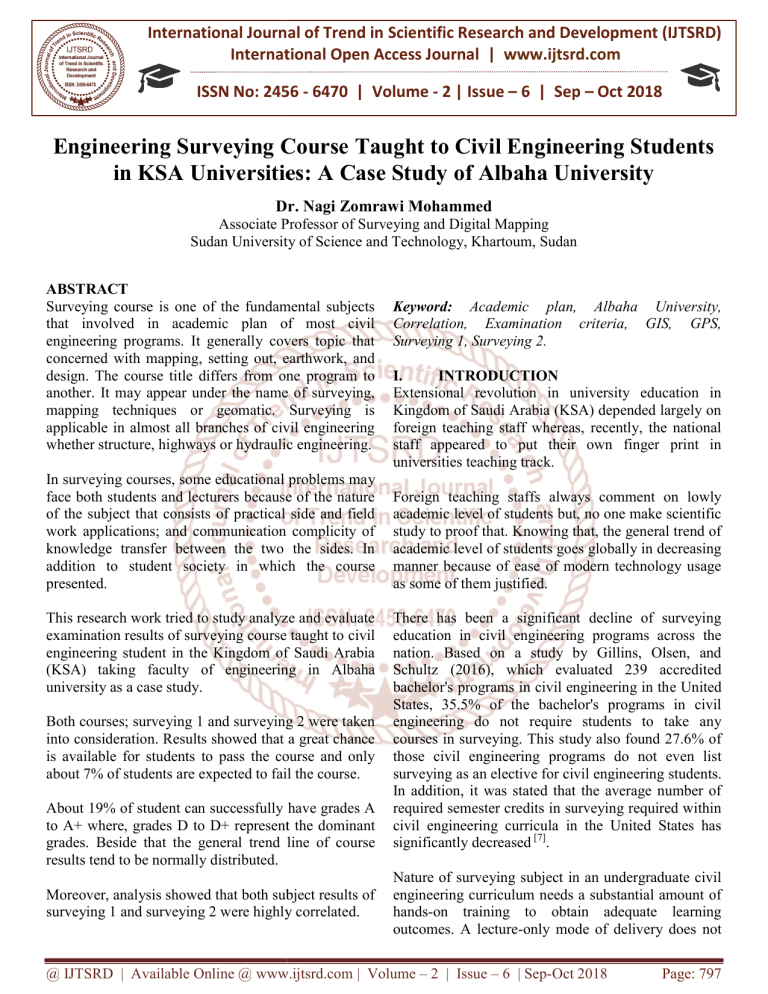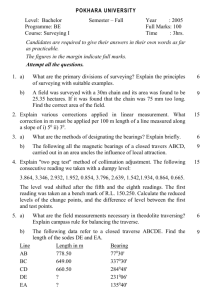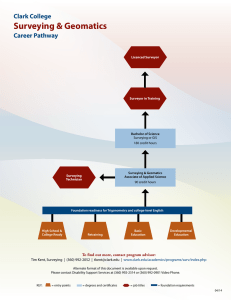
International Journal of Trend in Scientific Research and Development (IJTSRD)
International Open Access Journal | www.ijtsrd.com
ISSN No: 2456 - 6470 | Volume - 2 | Issue – 6 | Sep – Oct 2018
Engineering
eering Surveying Course Taught to Civil Engineering Students
in KSA Universities
Universities: A Case
ase Study of Albaha University
Dr. Nagi Zomrawi Mohammed
Associate Professor of Surveying and Digital Mapping
Sudan University of Science an
and
d Technology, Khartoum, Sudan
ABSTRACT
Surveying course is one of the fundamental subjects
that involved in academic plan of most civil
engineering programs. It generally covers topic that
concerned with mapping, setting out, earthwork, and
design. The course title differs from one program to
another.
nother. It may appear under the name of surveying,
mapping techniques or geomatic. Surveying is
applicable in almost all branches of civil engineering
whether structure, highways or hydraulic engineering.
In surveying courses, some educational problems ma
may
face both students and lecturers because of the nature
of the subject that consists of practical side and field
work applications; and communication complicity of
knowledge transfer between the two the sides. In
addition to student society in which the ccourse
presented.
This research work tried to study analyze and evaluate
examination results of surveying course taught to civil
engineering student in the Kingdom of Saudi Arabia
(KSA) taking faculty of engineering in Albaha
university as a case study.
Both
oth courses; surveying 1 and surveying 2 were taken
into consideration. Results showed that a great chance
is available for students to pass the course and only
about 7% of students are expected to fail the course.
About 19% of student can successfully have grades A
to A+ where, grades D to D+ represent the dominant
grades. Beside that the general trend line of course
results tend to be normally distributed.
Moreover, analysis showed that both subject results of
surveying 1 and surveying 2 were highly ccorrelated.
Keyword: Academic plan, Albaha University,
Correlation, Examination criteria, GIS, GPS,
Surveying 1, Surveying 2.
I.
INTRODUCTION
Extensional revolution in university education in
Kingdom of Saudi Arabia (KSA) depended largely on
foreign teaching staff whereas, recently, the national
staff appeared to put their own finger print in
universities teaching track.
Foreign teaching staffss always comment on lowly
academic level of students but, no one make scientific
study to proof that. Knowing that, the general trend of
academic level of students goes globally in decreasing
manner because of ease of modern technology usage
as some of them justified.
There has been a significant decline of surveying
education in civil engineering programs across the
nation. Based on a study by Gillins, Olsen, and
Schultz (2016), which evaluated 239 accredited
bachelor's programs in civil engineering in the
th United
States, 35.5% of the bachelor's programs in civil
engineering do not require students to take any
courses in surveying. This study also found 27.6% of
those civil engineering programs do not even list
surveying as an elective for civil engineering students.
In addition, it was stated that the average number of
required semester credits in surveying required within
civil engineering curricula in the United States has
significantly decreased [7].
Nature of surveying subject in an undergraduate civil
engineering curriculum needs a substantial amount of
hands-on
on training to obtain adequate learning
outcomes. A lecture-only
only mode of delivery does not
@ IJTSRD | Available Online @ www.ijtsrd.com | Volume – 2 | Issue – 6 | Sep-Oct
Oct 2018
Page: 797
International Journal of Trend in Scientific Research and Development (IJTSRD) ISSN: 2456-6470
2456
provide the adequate surveying skills needed by an
engineering student. In 2009, workshops were
introducedd for the Civil Engineering Drawing and
Surveying unit at Curtin University, Australia, with
the aim of offering students hands-on
on training in
surveying to enhance their learning. That study results
indicate that students were satisfied with the
workshops and recognized/perceived them to
contribute to the development of the learning
attributes they need to acquire [8].
II.
EDUCATION IN KSA
Governmental education in Kingdom of Saudi Arabia
(KSA) started by establishment of the directorate of
knowledge in 1925marked the launch of the first
regular educational system in the KSA and was the
bench mark of the boys' educational System in the
country.
The first Council for knowledge was established in
1927 with an aim to develop an educational system
that would monitor education in the Hijaz Region.
In 1951, the ministry of knowledge was established in
the reign of King Saud Bin Abdul Aziz. It was the
expanded and developed form of the directorate of
knowledge. Its functions were to plan, and monitor
boys' government education in primary, preparatory,
and secondary schools. King Fahd Bin Abdul Aziz
was the first minister of knowledge.
In 1960 the general presidency for girls’ education,
was established the reign of king Faisal Bin Abdul
Aziz. The presidency was responsible for 15 primary
schools and one female teachers’ intermediate
institute.
As education evolved, a royal decree was issued in
2002 to annex the general presidency for girls’
education, under the ministry of knowledge. Then
ministry of knowledge, was renamed the ministry of
education in 2003.
The ministry of higher education was established in
1975 to execute the Kingdom's policy on higher
education. The minister of education is responsible for
the implementation of the government's educational
policy.
Higher
education
has
received
enormous
governmental support; new universities, scientific and
applied colleges were established and huge funds
were allocated in budgets for higher education. Now
(2018) The number of Higher education institutions in
KSA has registered 26 government universities,
univ
10
private universities, and 41 private colleges. These
universities and colleges have scientific and applied
majors in different areas. The ministry of Higher
Education has also adopted modern approaches for
scientific research, and future planning.
plann
In 2015, the ministries of education and higher
education were merged into one entity, the ministry of
education.
III.
ALBAHA UNIVERSITY
Albaha University is a university in Albaha city, the
capital of Albaha province, Kingdom of Saudi Arabia.
It is a governmental
overnmental university that was established in
2006 with three faculties; Engineering, Science and
Applied Medical Sciences. At the present, the main
campus of the university located at Alaqiqtown about
25 km away from Albaha city [4]. The other campuses
are
re
in
Almikhwah,
Almandaq,
and
Baljurashiprovinces. The main campus in Alaqiq
occupies about 6.7 km2 including seven colleges of
the university. The university emphasizes public
services in all of its disciplines. The university
consists of 11 faculties:
1. The faculty of Medicine
2. The faculty of Engineering
3. The faculty of Applied Medical Sciences
4. The faculty of Administrative and Financial
Sciences
5. The faculty of Science
6. The faculty of Education
7. The faculty of Arts and Humanities
8. College of Science and Arts in Almikhwah
9. College of Science and Arts in Almandaq
10. College of Science and Arts in Baljurashi
11. Community College
In the past, faculty of engineering was belonging to
Umalqora University then, it was independent in 2006
with the establishment of Albaha University to be one
of its first founded faculties [3].
The faculty was started with three programs; civil,
architecture, and electrical engineering. Computer
engineering program was added as the fourth program
in 2011.
The faculty
lty include now about 1500 students coming
from different regions of the country.
@ IJTSRD | Available Online @ www.ijtsrd.com | Volume – 2 | Issue – 6 | Sep-Oct
Oct 2018
Page: 798
International Journal of Trend in Scientific Research and Development (IJTSRD) ISSN: 2456-6470
2456
IV.
COURSE
DESCRIPTION
AND
EXAMINATION CRITERIA
Academic plan 2010 (1432 Hijri) of civil engineering
program
described
Surveying
1(32011303)to
introduce students to surveying, tapping,
pping, levelling and
traversing through teaching students the basic concept
of surveying and its applications in tapping, levelling
and coordinates calculation. Engineering mathematic
was conditioned to be a prerequisite course for
surveying 1.
On the other
er hand the same academic plan stated the
objectives of Surveying 2(32011304) course is to
teach students the basic principles of engineering
surveying, principles of GPS and photogrammetric.
The course description includes horizontal and
vertical curves, methods of setting out, area and
volume computation, introduction to GPS and photogr
ammetry. The prerequisite course of surveying 2, was
surveying 1, where, surveying 2 itself represent a
prerequisite course for both Geographic Informatio
Information
System (GIS) applications and Global Positioning
System (GPS) Applications [1].
Both courses evaluation divided into two main
components; course work and final exam. Course
work have 60% weight including attendance,
laboratory, mid-semester exam, quizzes,
s, exercises and
homework’s. Where, the remaining 40% left for the
final exam. By this evaluation, great chance for the
student to pass the course and have advance grades.
Examiner used to prepare quizzes and examinations
that proportional to students capabilities
abilities taking into
account the mathematical background and secondary
school educational level that students came from.
Although these examinations were not so difficult,
they were also not simple as well and students success
to gain good marks.
Types of examination questions used were of the
following types:
A. Direct computational questions that require
students to perform calculations in order to solve
for an answer.
B. Short answer questions which composed of a brief
prompt that demands a written answer of few
sentences testing the basic knowledge of key facts
and terms of the syllabus.
C. Multiple choice questions composed of one
question with multiple possible answers, including
the correct answer.
D. Matching questions that sometimes appeared as
table or fill-in-the-blank.
E. True/false questions that only composed of a
statement. Students respond to the questions by
indicating whether the statement is true or false.
Although this types of question were used to be
b
given but, some student fail to answer correctly.
V.
DATA AND ANALYSIS
According to exam regulations in Albaha university,
the evaluation of each student in a particular course
subjected to the following graduation table:
Table 1: University exam grading system.
Grade
Marks
Code Points
Exceptional
95-100
100
A+
4.00
Excellent
90-94
94
A
3.75
Superior
85-89
89
B+
3.50
Very good
80-84
84
B
3.00
Above average
75-79
79
C+
2.5
Good
70-74
74
C
2.00
High pass
65-69
69
D+
1.5
Pass
60-64
64
D
1.00
Fail
Less than 60
F
0.00
In-progress
IP
To simplify and summarize analysis for this study,
five graduation categories were suggested. These
graduations are; A, B, C, D and F. Where, A included
A to A+and soon according to the following table.
Table 2: Summarized graduation system.
Exam code Summarized code
A to A+
A
B to B+
B
+
C to C
C
D to D+
D
F
F
Data for this research work was extracted from
university examination records during the period of
study through academic years 2015 up to 2018.
Registered students for both subjects surveying 1 and
surveying 2 were found to be as arranged in table (3)
below.
Table 3: Registered students for surveying.
Registered student
Academic Year
Surveying 1 Surveying 2
2015/2016
66
48
2016/2017
46
49
2017/2018
56
61
@ IJTSRD | Available Online @ www.ijtsrd.com | Volume – 2 | Issue – 6 | Sep-Oct
Oct 2018
Page: 799
International Journal of Trend in Scientific Research and Development (IJTSRD) ISSN: 2456-6470
2456
Final results of student evaluation for surveying 1
during the study period were extracted
extracted. Percentages
were calculated for each grade. Then, Average
percentage grades were calculated for the three
academic years as shown in table (4) hereunder.
Table 4: Results of surveying 1.
Percentage grade
Academic year
A B C D F
2015/2016
23 23 15 27 12
2016/2017
11 20 24 36 9
2017/2018
15 26 31 25 3
Average
16 23 23 30 8
Figure (1) below illustrates the average grade of
student results of surveying 1.
Fig 2: Average grades in surveying 2
From the figure it could be noted that student’s
achievement in surveying 2 was improved compared
c
with surveying1. Though, 95% of students success to
pass the subject and 21% of them had grade A.
Again, grade D was the highest grade with 25% of the
total number of students.
Correlation between average grade of both surveying
1 and surveying 2 can be calculated as 0.9 that means
the two subjects are highly correlated.
Average grade for both surveying 1 and surveying 2
can be reduced as a final result as presented in table
(6) hereunder.
Fig 1: Average grades in surveying 1
It can be noted that 92% of students success to pass
the subject and 16% of them had grade A. in opposite,
grade D appeared as the highest grade.
Table 6: Final results.
A
B
C
D
F
Grade
Average 18.5 24.5 23 27.5 6.5
Again, the final result can be shown in a bar graph as
illustrated in figure (3).
Student’s results in surveying 2 were also collected
and arranged similarly as presented in table (5). Again
average grades were calculated.
Table5: Results of surveying 2.
Percentage grades
Academic year
A B C D F
2015/2016
21 22 25 25 7
2016/2017
12 25 22 39 2
2017/2018
30 30 23 10 7
Average
21 26 23 25 5
For the three academic years of study period, the
average of each grade plotted in bar graph as
illustrated in figure (2) below.
Fig 3: Final results.
From figure (3), the trend line generally tend to be
normally distributed where, about 97% of students has
a chance to pass. Also, grade D represent the highest
percentage grade as noted before.
@ IJTSRD | Available Online @ www.ijtsrd.com | Volume – 2 | Issue – 6 | Sep-Oct
Oct 2018
Page: 800
International Journal of Trend in Scientific Research and Development (IJTSRD) ISSN: 2456-6470
2456
VI.
CONCLUSION
In this research work, Albaha university was taken as
a sample case in Kingdom of Saudi Arabia
universities to study, analyze and evaluate
examination results of surveying course taught to civil
engineering students.
Student results in both surveying courses
courses; surveying 1
and surveying 2 were taken
ken into consideration. Data
was collected and analyzed for three academic years
years.
Results of the research study can be concluded in the
following points:
According to examination rules, course work
evaluation gives good chance for students to
assess themselves
es before the final exam.
A great chance is available for students to pass
surveying subjects.
A chance available for about 19% of students to
have grade A or better.
Grades D and D+ are the dominant grades.
In general, students improve their achievement in
the second course of surveying compared with the
first one.
Results of the two subjects; surveying 1 and
surveying 2 were found to be highly correlated
and go hand by hand with each other.
References
1. Academic
mic plan (2010), faculty of engineering,
Albaha University.
2. Examination records (2016), (2017), (2018),
Albhaha University.
3. Faculty of engineering strategic plan, (2017)
Albaha university records.
4. https://en.wikipedia.org/wiki/Al_Baha_Universit
edia.org/wiki/Al_Baha_Universit.
5. https://en.wikipedia.org/wiki/Ministry_of_Educati
.wikipedia.org/wiki/Ministry_of_Educati
on_(Saudi_Arabia).
6. https://uwaterloo.ca/centre-for-teachinghttps://uwaterloo.ca/centre
excellence/teaching-resources/teaching
resources/teachingtips/developing-signments/exams/questions
signments/exams/questions-typescharacteristics-suggestions.
suggestions.
7. https://www.asce.org/utility-engineering-andhttps://www.asce.org/utility
surveying/news/20180228-surveying-in-civilsurveying/news/20180228
engineering-education/.
8. https://www.researchgate.net/publication/3124792
67_Enhancing_Civil_Engineering_Surveying_Lea
rning_through_Workshops.
@ IJTSRD | Available Online @ www.ijtsrd.com | Volume – 2 | Issue – 6 | Sep-Oct
Oct 2018
Page: 801



